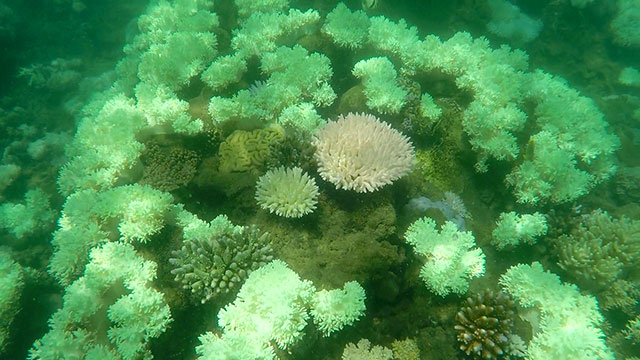
Part of the Series
Planet or Profit
When he was six years old, Dean Miller already knew he wanted to be a marine biologist. At that time, growing up in Australia, the world of marine biology seemed both spectacular and limitless, he says.
“I wanted to study the wonders of the Great Barrier Reef, the intricate and complex connections between the thousands of different life-forms that represent the most diverse ecosystem on the planet,” Miller told Truthout.
But in the last two years, this has all changed for him.
To see more stories like this, visit “Planet or Profit?”
“I now look at the reef as an ecosystem that is suffering from our actions and I feel guilty beyond belief that this is happening in my backyard, on our generation’s watch,” he explained. “I no longer dream of the kaleidoscope of life, color and movement that represents the world’s coral reefs. Instead, I worry and fight for the actual existence of coral reefs as we know them, as the changes I see are happening all too quickly — much quicker than the reef can adapt.”
This is because over the last two years, the Great Barrier Reef, which is so dear to Miller and countless others who revel in the beauty and mysteries of the oceans, has been dying off at an unprecedented rate due primarily to warming ocean waters.
Coral bleaching occurs when corals become stressed by warmer-than-normal water, causing them to expel symbiotic algae that live in their tissues, from which they get their energy. Coral turns completely white when it bleaches. If it remains bleached long enough, it dies.
One scientist has already gone so far as to declare the Great Barrier Reef is now in a “terminal stage.” Most of those studying the reef agree that what is happening is unprecedented. This is because, at a minimum, two-thirds of the 1,400-mile long reef bleached out last year, which led to 22 percent of it dying. Now another bleaching event has resulted in at least two-thirds of the reef bleached again.
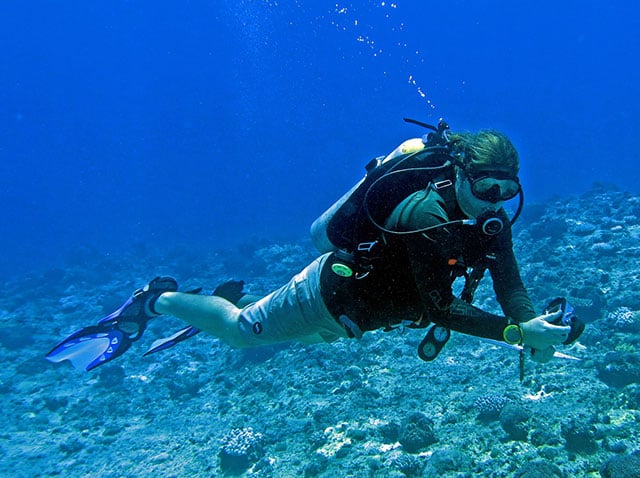 Marine biologist David Burdick, who has been studying the coral around Guam for more than 10 years, told Truthout the frequency of bleaching events he is seeing “is all new to us.” (Photo: Courtesy of David Burdick)
Marine biologist David Burdick, who has been studying the coral around Guam for more than 10 years, told Truthout the frequency of bleaching events he is seeing “is all new to us.” (Photo: Courtesy of David Burdick)
“The bleaching this year has moved much farther south and has taken scientists by surprise in its severity and extent,” Miller said. And he fears the state of the reef could be even worse than scientists realize, since only aerial surveys have been conducted to assess the damage and no research vessel is currently active on the reef to provide finer details.
With ocean temperatures rising across the globe as anthropogenic climate disruption (ACD) continues to pick up speed, the Great Barrier Reef, the largest coral ecosystem on Earth, may well be an example of what is happening to all of the coral on the planet.
“This Is New for All of Us”
Marine biologist David Burdick coordinates a NOAA-funded long-term coral reef monitoring program out of the University of Guam Marine Laboratory, and has been conducting field studies of Guam’s coral reefs for more than a decade.
“In 2013, we had a moderate to severe bleaching event that came out of nowhere and lasted for three months, and we lost a quarter of the coral that was impacted from the 80 percent of the coral species that bleached,” Burdick told Truthout during a recent interview on Guam.
Then, less than seven months later, what he called “an unusual sea-surface temperature spike” caused another moderate to severe bleaching event. “Corals that were already weakened by the 2013 event — many of them died,” he explained. “The event was fairly widespread, and corals that survived the 2013 event did not survive this one.”
Fifty percent of the coral that bleached during the 2014 event died.
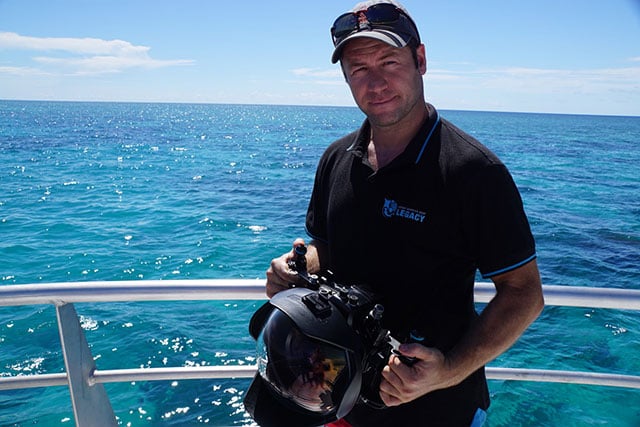 Dean Miller, a marine scientist with Great Barrier Reef Legacy, a nonprofit environmental organization that works to promote better stewardship of the reef by providing free access for scientists. (Photo: Dahr Jamail)
Dean Miller, a marine scientist with Great Barrier Reef Legacy, a nonprofit environmental organization that works to promote better stewardship of the reef by providing free access for scientists. (Photo: Dahr Jamail)
“Then, while we were still analysing all of our data from that event, we had another large bleaching event in 2016,” Burdick said. “So we had three major bleaching events, essentially having one per year, which is a pattern now, apparently.”
Prior to these events, they’d never seen anything on Guam that would be classified beyond a “moderate” coral bleaching event.
“This is all new for us,” Burdick said.
Miller is equally stunned by what he is seeing along the Great Barrier Reef, which is eerily similar to what Burdick is seeing on Guam.
“Parts of the reef that didn’t bleach last year are now under immense pressure, and this is totally different because this is back-to-back bleaching,” Miller explained. “The system was already stressed, and this is a new stress event. We are seeing much mortality on reefs in our area…. What didn’t die last year is dying this year.”
In addition to the new bleaching in this year’s event, southern portions of the reef that are typically in cooler waters are now also bleaching out.
“It’s heartbreaking to see,” Miller added. “Seventy thousand direct tourism-related jobs and a $6 billion tourism industry are all at risk, especially on top of the recent damage from Cyclone Debbie.”
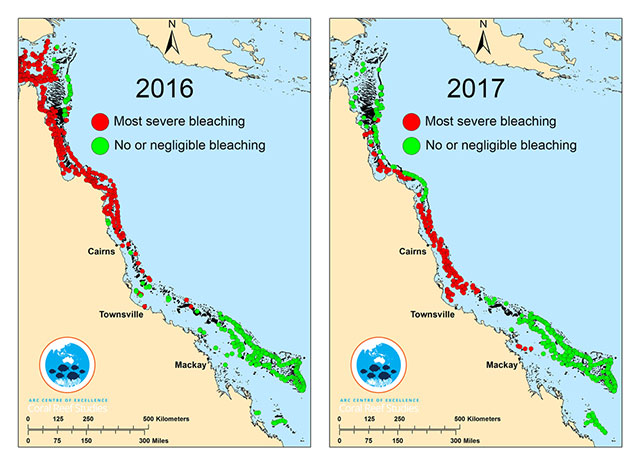 According to Dean Miller, this year’s Great Barrier Reef coral bleaching event has taken scientists “by surprise by its severity and extent” and is occurring much further south than last year’s, which killed 22 percent of the reef. (Photo: Courtesy of ARC Centre of Excellence for Coral Reef Studies)
According to Dean Miller, this year’s Great Barrier Reef coral bleaching event has taken scientists “by surprise by its severity and extent” and is occurring much further south than last year’s, which killed 22 percent of the reef. (Photo: Courtesy of ARC Centre of Excellence for Coral Reef Studies)
A study published this March in the journal Nature found that last year’s bleaching of the Great Barrier Reef was so severe that there was no similar analog in the thousands of years of ancient coral cores scientists use to study past climates.
Another study published in Nature projected that by the year 2050, more than 98 percent of global coral reefs will be afflicted by “bleaching-level thermal stress” every single year.
However, the prognosis could be even worse: The scientists involved in the study from this March speculated that the era of never-ending global coral bleaching may have already arrived, albeit several decades earlier than was predicted even just last year. They explained that the Great Barrier Reef needs 10 to 15 years between bleaching events in order to fully recover, and that recovery time period is “no longer realistic.”
“We Don’t Even Know What We Are Losing”
Laurie Raymundo is a coral ecologist at the University of Guam Marine Lab who has worked closely with Burdick for years. Similar to Miller, she knew when she was 11 years old that she wanted to study coral. She now teaches at the University of Guam, and is designing a course in coral reef ecology and management that will include ACD impacts. She has lived in Guam since 2004 and is a co-author of the 2016 Paris Climate Agreement.
Like the other scientists Truthout spoke with, Raymundo is deeply troubled by what she is seeing.
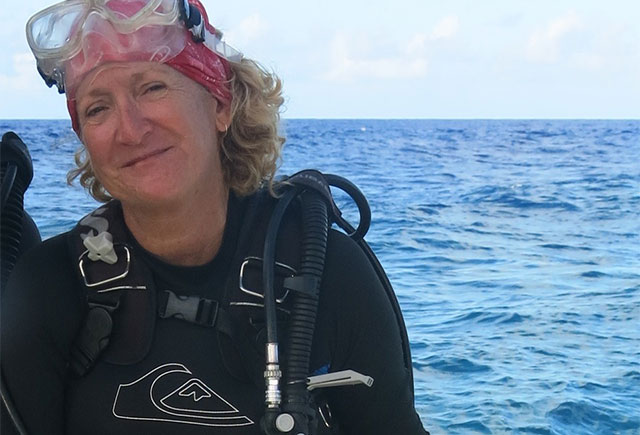 Coral Ecologist Laurie Raymundo with the University of Guam is a co-author of the 2016 Paris Climate Agreement. (Photo: Courtesy of Laurie Raymundo)
Coral Ecologist Laurie Raymundo with the University of Guam is a co-author of the 2016 Paris Climate Agreement. (Photo: Courtesy of Laurie Raymundo)
If we lose coral reefs, Raymundo warned Truthout, “We will lose all our sensitive species, and we will have lower diversity.”
Equally worrying to her is the fact that there is still so much we don’t know about the importance of coral reefs.
“We don’t even know what we are losing, and we don’t understand what a loss of biodiversity fully means, for pharmaceuticals, ecologically, and in so many other ways,” she said. “We are losing things before we even actually know, fully, what we are losing.”
A report by the UN’s Food and Agriculture Organization shows that coral reefs are responsible for producing 17 percent of all globally consumed protein, with that ratio being 70 percent or greater in island and coastal countries like those of Micronesia.
At the time of this writing, Earth has lost nearly half of its coral, and oceanic warming only continues to accelerate.
“We are finding that reefs living under anthropogenic stresses for many years have already lost their more sensitive coral species, and the ones that are there now are already the tough bastards,” Raymundo said. “And when reefs have lower diversity, there is less ecological redundancy; hence, they are more likely to collapse.”
A Future Without Coral?
A 2012 study revealed that half of the Great Barrier Reef had already vanished in just the previous 27 years. Two years later, the world’s most qualified coral reef experts released a report showing that, without dramatic intervention, the Great Barrier Reef would disappear completely by 2030.
Furthermore, a study published and released by NOAA in 2011 warned that, “unless action is taken now to reduce the threats,” 90 percent of all reefs will be “threatened” by 2030, and all of Earth’s coral reefs could be completely gone by 2050. The study, “Reefs at Risk Revisited,” listed human-caused climate disruption, warmer water temperatures, ocean acidification, shipping, overfishing, coastal development and agricultural runoff as the contributing factors.
While that might sound extreme, Miller told Truthout he thought the report actually didn’t go far enough.
“I think it’s too conservative,” he explained. “Corals need many years to adjust to the warmer ocean waters, and we don’t have that kind of time anymore. The warming we are seeing now is happening far too fast to allow for evolution…. So what we’re seeing now is death. That’s what bleaching is.”
Burdick, who described Guam’s reefs as “getting clobbered,” agreed.
“Various factors will buy some areas some time, so some coral species might eek out a bit longer, for a while,” he said. “But [with] bleaching events every five to 10 years, you won’t give coral enough time to come back to where it was. It is all about the rate of change. And right now, that rate is increasing, and rapidly at that.”
Back in Australia, Miller is dismayed by the fact that his government is doing very little, if anything, to mitigate the crisis.
Truthout asked Miller what steps the Australian government is taking to save the Great Barrier Reef.
“From what I can tell, virtually nothing,” he answered. “They are not focussed on this at all, but rather are pushing for the Adani Coal Mine to go ahead. We here in Australia can hardly believe it, to be honest. In fact, the government has had almost no comment on the bleaching at all.”
The coal mine he referred to is looking like it is going to move forward, which will, according to Miller, bring an additional 500 ships carrying coal across the Great Barrier Reef every single year.
Truthout interviewed Miller’s colleague, John Rumney, the managing director of Great Barrier Reef Legacy in February, when this year’s bleaching event began.
“This coral is in big trouble,” Rumney said at the time. Like Miller, Burdick and Raymundo, Rumney warned of the extreme loss of biodiversity that comes with the disappearance of reefs.
“When all that coral goes, all that diversity of fish that depends on it goes,” Rumney told Truthout. “The entire food chain is in big trouble.”
Miller concurred, saying, “We might see ecosystem collapse as we know it.”
The need for independent research on the Great Barrier Reef during this second mass-bleaching event is needed more than ever, according to Miller. His and Rumney’s organization is striving to get more scientists out to the reef as quickly as possible.
“The world’s greatest natural icon and largest living structure needs our help more than ever, and unless we act as a concerned global population, nothing will be done,” he concluded. “It is not too late. The reef is worth saving — and our actions now will determine the fate of coral reefs in as little as 5 to 10 years. We must act.”
Join us in defending the truth before it’s too late
The future of independent journalism is uncertain, and the consequences of losing it are too grave to ignore. To ensure Truthout remains safe, strong, and free, we need to raise $27,000 in the next 24 hours. Every dollar raised goes directly toward the costs of producing news you can trust.
Please give what you can — because by supporting us with a tax-deductible donation, you’re not just preserving a source of news, you’re helping to safeguard what’s left of our democracy.